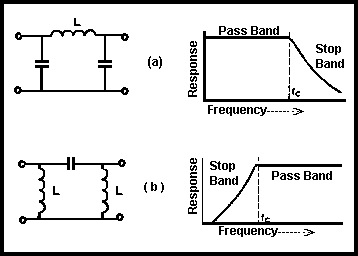
Filters, or to give them their full name 'wave filters', are passive networks of capacitors and inductors which exhibit certain characteristics as the input frequency is varied.
The filters of most interest in amateur radio are:
The specified frequency referred to is the 'cut-off frequency' (fc). The configuration of the simplest form ('single section') of each filter is shown in Fig 2.17 which also shows the general shape of the characteristics.

Fig 2.17. (a) Single-section low-pass filter configuration and its response curve; (b) single-section high-pass filter configuration and its response curve
Two or three (or occasionally more) single-section filters may be connected in cascade to increase the rate of the fall-off of the response in the stop band. Further improvement may be achieved by connecting a series arrangement of inductance and capacitance ('half sections') across the input and output of the filter.
Although not strictly a wave-filter, a 'T-notch filter' has uses in amateur radio. This provides a tuneable and very sharp 'null', ie a large attenuation over a narrow frequency band.
Filters have a number of important applications in amateur radio. Low-pass filters are used to attenuate unwanted frequencies in the output of the HF bands transmitter (transmitter-antenna matching unit connection). Another use is to limit the audio bandwidth of a telephony transmitter to the minimum necessary for intelligible communication.
The high-pass filter may be used in the antenna down-lead (coaxial cable) of a television receiver in order to attenuate unwanted frequencies.